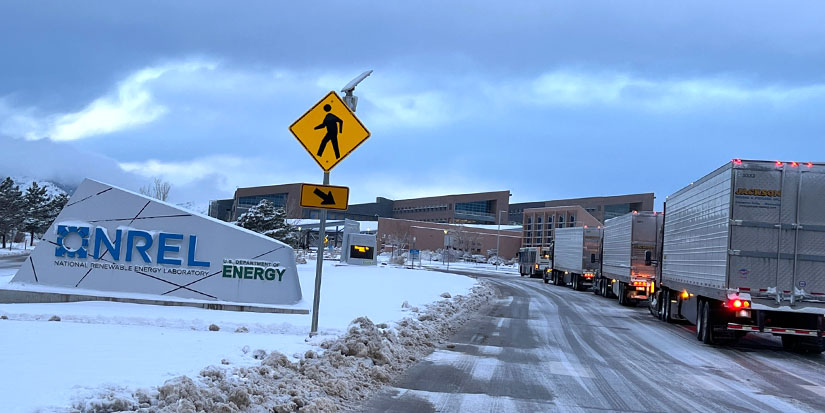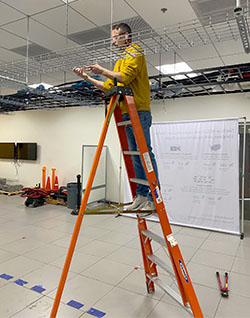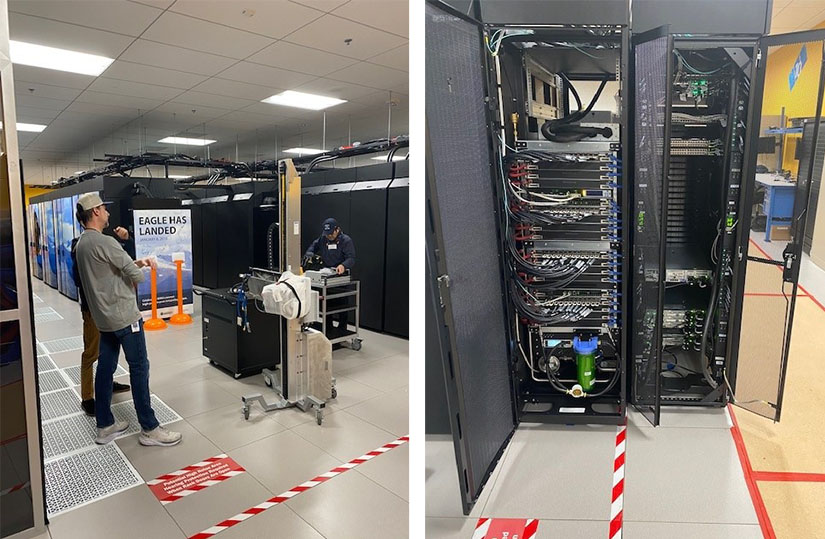Kestrel Computing System Countdown
Read blogs about the installation of NLR's Kestrel high-performance computing (HPC) system.

Feb. 15, 2024
Last week, Kestrel's GPU-accelerated nodes arrived, and the Kestrel team, alongside
Hewlett Packard Enterprise engineers, began installing them in the Energy Systems
Integration Facility’s HPC data center. The GPU nodes will play a critical role in
supporting advanced applications and technologies in artificial intelligence and machine
learning in energy research. When the installation is complete, Kestrel will have
132 GPU nodes added to the existing CPU capacity, with each GPU node hosting 4 NVIDIA
H100 GPUs. With Kestrel soon to be at its full capacity of 44 petaflops, researchers
will be empowered to tackle more complex, data-centric research questions towards
a renewable future.
July 18, 2023
There are a lot of numbers and terms when it comes to the new Kestrel HPC system.
44 petaflops; 2,456 nodes; 95 petabytes; we could go on. Beyond the numbers, Kestrel
represents a significant expansion in the capabilities and computing power for NREL
and its partners at the U.S. Department of Energy and beyond. With faster, more robust
computing capabilities, Kestrel will allow energy research at NREL to soar to the
next level.
In a short video, hear why Kestrel’s impressive speed really matters, according to Surendra Sunkari, NREL HPC engineer and Kestrel technical lead.
July 6, 2023
There are a lot of numbers and terms when it comes to the new Kestrel HPC system.
44 petaflops; 2,456 nodes; 95 petabytes; we could go on. Beyond the numbers, Kestrel
represents a significant expansion in the capabilities and computing power for NREL
and its partners at the U.S. Department of Energy and beyond. With faster, more robust
computing capabilities, Kestrel will allow energy research at NREL to soar to the
next level.
In a short video, hear why Kestrel's advanced capabilities really matter, according to Aaron Andersen, group manager of Advanced Computing Operations with NREL's Computational Science Center.
June 28, 2023
Building Kestrel has been a massive, coordinated effort. Read about Kestrel’s supporting cast bringing Kestrel to NREL.
June 21, 2023
There are a lot of numbers and terms when it comes to the new Kestrel HPC system. 44 petaflops; 2,456 nodes; 95 petabytes; we could go on. Beyond the numbers, Kestrel represents a significant expansion in the capabilities
and computing power for NREL and its partners at the U.S. Department of Energy and beyond. With faster, more robust computing capabilities, Kestrel will allow energy research at NREL to soar to the next level.
In a short video, hear why Kestrel’s power really matters, according to Kristin Munch, NREL’s Advanced Computing laboratory program manager.
June 15, 2023
The team continues to put Kestrel into place, preparing for full operation later this summer. Everything is coming together. Watch our newest video highlighting the technical team as they continue this amazing journey
to help Kestrel take flight.
May 22, 2023
Today was a very exciting day for Kestrel! U.S. Secretary of Energy Jennifer Granholm visited the NREL campus to help showcase and celebrate the laboratory's new campus expansion projects. Among many exciting activities
of the day, the secretary joined NREL staff and representatives from Hewlett Packard Enterprise to sign the supercomputer!

The honorable Jennifer Granholm, U.S. Secretary of Energy, signs a banner on the Kestrel supercomputer. Photo by Sophia Faraca
"What an amazing opportunity to have Secretary Granholm celebrate Kestrel with us," said Kristin Munch, NREL's Advanced Computing laboratory program manager. "Our team was honored to have this opportunity to showcase Kestrel and celebrate the next chapter of supercomputing capabilities for NREL and the U.S. Department of Energy. We're grateful to the many NREL staff, media, and distinguished guests who participated in today's activities."
Thank you to Secretary Granholm and the many other distinguished visitors who visited NREL today to celebrate Kestrel and other campus expansions.

Secretary Granholm gets a behind-the-scenes look at the new Kestrel high-performance computing (HPC) system in the Energy Systems Integration Facility at NREL. Photo by Werner Slocum
May 10, 2023
44 petaflops.
95 petabytes of data storage.
604 terabytes of total memory.
Kestrel will make our research faster and more efficient than ever. See how Kestrel stacks-up by the numbers.
May 2, 2023
Kestrel is now in the final stages of hardware installation, and the team is working
out final network configurations and access points for the compute and storage parts
of Kestrel as the whole system gets integrated into the Energy Systems Integration
Facility data center. "This part of the installation is critical as we make sure all
the hardware components are working as expected and that Kestrel's internal network
is configured as well as its connectivity to the rest of the data center. Taking the
time to get things right now will make all the difference down the line," said Surendra
Sunkari, the Kestrel installation technical lead.
April 11, 2023
Kestrel is now fully cabled, and all compute nodes are connected to the high-speed
network and storage. The doors were hung, and the graphics were applied. Kestrel is
taking shape!

Kestrel cabling was underway this week. Photo by Bill Honeycutt.
Over the course of Kestrel’s initial setup, we shot a timelapse video of the process.
Timelapse video of the crew cabling Kestrel.

April 3, 2023
Kestrel's CPU nodes are now placed in NREL's HPC Data Center in the Energy Systems Integration Facility data center, with preliminary power and cooling tests ongoing including flowing water
from the facility to the cooling distribution units. The storage dedicated to Kestrel
has also moved in, with nearly 9,000 hard drives installed last week. The team is
starting to cable the network to connect all of Kestrel's components and performing
component level diagnostics.
March 27, 2023
It's here! On a snowy and chilly Colorado morning, the trucks arrived right on schedule
to deliver the Kestrel elements to NREL's main gate.

Trucks arrive at NREL to deliver the Kestrel supercomputer. Photo by Kris Munch.
After initial safety briefings, the operations team got right to work to move equipment from the trucks into NREL’s data center, the future landing place for Kestrel.

The team moves the boxes and Kestrel elements into place in NREL's data center. Photos by Jennifer Southerland.
The team will continue building Kestrel over the coming months, conducting further software testing, and incorporating the next equipment deliveries to power our most comprehensive and transformative energy solutions yet.
Timelapse video of the Kestrel supercomputer arriving at NREL on March 27, 2023.

March 9, 2023
Yesterday, Encore Electric wrapped up the final wire installation, providing almost
2 megawatts of electrical distribution to a single row of computing equipment. Roy Fraley and Chris Burke are now able to install a basket tray that will allow us to connect
the storage system to the compute cabinets.
"Systems of the size and scale of Kestrel don't just plug into the wall like your laptop, so kudos are in order to Site Ops, ESIF Ops, Encore Electric, and the ACO team, all doing a great job getting the data center prepared," explains Aaron Andersen, group manager of Advanced Computing Operations with NREL's Computational Science Center.
Feb. 28, 2023
Several team members visited the Hewlett Packard Enterprise (HPE) factory in Wisconsin
in mid-February to get a final review of the Kestrel Phase 1 before it ships to NREL.
The team was able to check out the facility connections for the power and cooling
infrastructure on Kestrel and validate the system's operations in HPE's data center,
including logging in to the system for the first time.
"Getting an early look at these connections and verifying the power components while in factory is critical to ensuring a smooth install when it arrives at NREL," explains Roy Fraley, high-performance computing data center engineer with NREL's Computational Science Center.
Jan. 6, 2023
At last! Kestrel is about to hatch…or rather, its baby sibling, Eyas.
The first pieces of the "test and development" system, Eyas, arrived at NREL in late December and the team has now gotten to work. Eyas is a much smaller system that will help NREL's team of computer scientists prepare for the large-scale installation and operations of Kestrel before it arrives in March. Eyas will help the team improve cyber-security posture, test software, and prepare the environment ahead of the full Kestrel build.
"Eyas has proven exceptionally valuable as we have been able to identify some issues in the software stack, correct those and provide hands on training to staff ensuring that common NREL models and applications are ready for the Kestrel system", said Aaron Andersen, group manager of Advanced Computing Operations with the Kestrel project.

Dec. 21, 2022
Not the news we wanted! The Kestrel team was notified in December 2022 that the delivery
of the central processing unit (CPU) nodes for Kestrel would be delayed due to supply
chain disruptions. This delay will postpone Kestrel's availability for use until mid-summer
2023.
May 1, 2022
NREL's incoming high-performance computing system—Kestrel—will have superior advanced
supercomputer capabilities compared to its predecessor, Eagle. For example, if the
two were side by side on subway tracks, Kestrel would travel 5.5 times faster than
Eagle.
See more real-world examples on how the Kestrel versus Eagle supercomputer stack-up.
Dec. 1, 2021
NREL publicly announces that Hewlett Packard Enterprise will build its third-generation,
HPC system, called Kestrel. When Kestrel takes flight, it will help the United States
soar toward a clean energy future. Read how NREL acquired the next-generation HPC system.

Share
Last Updated Dec. 7, 2025
